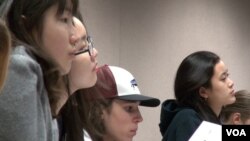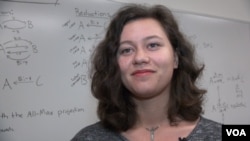In a computer lab at Harvey Mudd College in California, a small robot performs the graceful movements of tai chi, an ancient Chinese meditation exercise. Student Jane Wu writes instruction codes from a nearby computer, showing a visitor a simple form of robotics and artificial intelligence.
Wu is a third-year student in mathematics and computer science at the college, a leader in attracting women to high technology.
“I think the moment for me was during my freshman robotics elective [class] that I took, called Autonomous Vehicles,” she said of her decision to pursue a computer science career, “and in that class we got to make our own autonomous robots from scratch.”
Harvey Mudd College, with just 800 students, stresses engineering, and is part of an educational cluster called The Claremont Colleges, in the eastern suburbs of Los Angeles. It was named after a mining engineer who helped to found the school.
The school overhauled its computer science program a decade ago to make the discipline less intimidating to those with little background in computers. The effort has yielded results: last year more than half of the college’s graduates in computer science were women. Students are initially placed in academic streams based on their knowledge of computers to reduce the intimidation factor, and many later come to understand that computer science is “a beautiful intellectual discipline,” says professor Ran Libeskind-Hadas, “but also, or course, a useful and practical one.”
Taste of coding
The introductory computer class, a requirement for all students, sparked the interest of senior Veronica Rivera, who is majoring in computer science and mathematics.
“It was a very balanced class,” she said, “and I think the professors also do a very good job of making sure everyone feels welcome, regardless of their coding ability.”
Rivera hopes to develop computer applications to help people with motor impairments.
Women were prominent coders in the early days of computers when Grace Hopper, who was later became a U.S. Navy rear admiral, helped invent programming languages, says Jim Boerkoel, an assistant professor who oversees the robotics lab.
“She [Grace Hopper] is the original coder,” Boerkoel said. “It was only in later decades, the 1980s and 90s, that computer games and the idea of computer programming got heavily marketed toward boys rather than girls.”
Women technologists
At Harvey Mudd, some women who come to study engineering rediscover programming, and each year, dozens attend the annual Grace Hopper Celebration of Women in Computing, the world’s largest conference of women technologists.
“With coding, I can just have my computer, have some programming language I’m working in, and I can make almost whatever I want,” said computer science major Emilia Reed, who is helping create computer apps to enhance the productivity of workers and students.
Internships in industry are part of the training, and third-year student Samantha Andow will intern at Microsoft in Redmond, Washington, later this year.
“I’m really excited to see all the problems that computer science is working on right now,” she said.
Computers are integral to all areas of life, and the field needs the best and the brightest, notes Maria Klawe, president of Harvey Mudd.
“If we don’t manage to get a more diverse community into technology,” she said, “we’re not going to get as good solutions, as much progress as we need on the problems facing the world, whether it’s climate change or education, health care.”
Klawe says today’s challenges require the creativity that diversity brings, and that the field needs more on women and minorities — both underrepresented in the high-tech industry — as future programmers.












